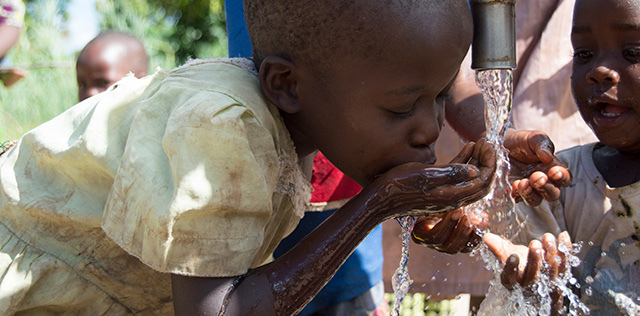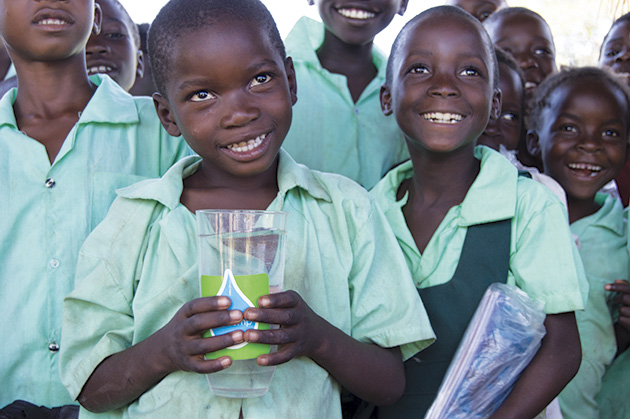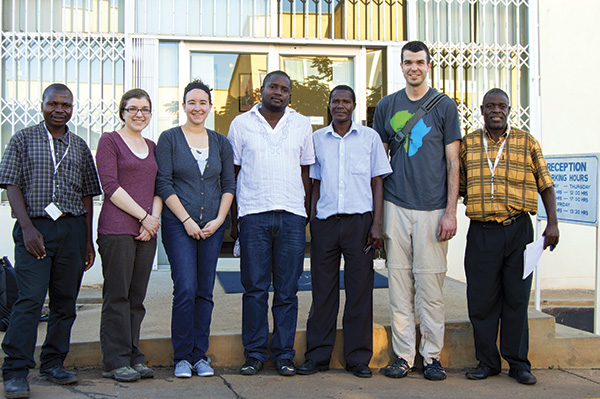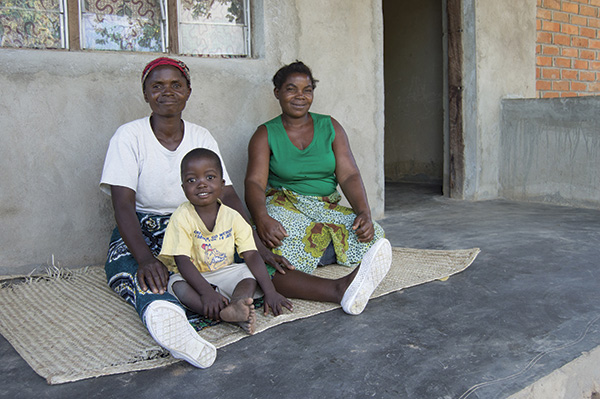
In the heart of the Kasungu District in the Central Region of Malawi, a 45-year-old grandmother of six stoops to slice fresh okra into a large woven basket. The red brick behind her glows against the backdrop of lush green Acacias, banana trees and broad tobacco leaves. It is the end of the rainy season, and soon the crops will be harvested and dry air will suck the life out of the ground. Even during Malawi's driest days, the bucket of clear, cool water sitting in the red dust by this woman's feet will be filled again and again. Children will continue to drink, and gardens will still grow. For Vickness Nyirenda and her neighbors in Zolomondo village, a simple hand pump has changed everything.
The Gift of Clean Water
In November 2013, Zolomondo received a gift that transformed the entire community: a deep-well, progressive cavity (PC) hand pump known as the LifePump. Provided by humanitarian engineering nonprofit Design Outreach in partnership with World Vision and private donors, the LifePump is engineered to reach depths of 325 feet—more than twice that of a typical hand pump. It supplies a consistent flow of clean water, which for this community, is life-saving. Supplied by SEEPEX, a German-based pump manufacturer, the LifePump's PC pumping elements work to continuously and efficiently move water to the surface with every turn of the handle. Unlike piston pumps that lift the entire column of water with one push of the lever, this design allows virtually anyone—regardless of strength or size—to access safe water. Nyirenda no longer has to wait for hours or hack away at the earth with a hoe to ensure her family has enough water to survive. She no longer has to fear for her life. "Even if I come to the pump late or there are others gathered," Nyirenda says in native Chewa, "my family and I are certain we will get water." This design gives her confidence that she can easily pump the water herself and that there will be enough.Reaching New Depths
.jpg) Dr. Greg Bixler, CEO & co-founder of Design Outreach, offers training in Zambia. (Photos by Amelia Messamore)
Dr. Greg Bixler, CEO & co-founder of Design Outreach, offers training in Zambia. (Photos by Amelia Messamore).jpg) A woman in Malawi gathers water from a polluted water source that serves 1,100 people.
A woman in Malawi gathers water from a polluted water source that serves 1,100 people.The Power of Water
Water, as Nyirenda knows, is a powerful thing. Her village is living proof. Less than two years ago, the lives of Nyirenda and her neighbors ticked away as they waited at a watering hole that produced just a trickle of water. The women would walk two kilometers deep into the African grassland in the afternoon, only to return the next morning with dirty water laden with disease. The women, already exhausted from only three to four hours of sleep every night, would often bring hoes to increase their chances of finding water. "Since water is life," Nyirenda says, "we had no option but to dig down to get it." While they waited as long as 12 hours for water to flow, wild animals from a nearby national park would sometimes wander beyond their territories to drink from this same water source. "Sometimes we'd be chased by hyenas," Nyirenda says. "We were afraid that wild animals would kill us." The water they returned with was rarely sufficient for daily needs. Nyirenda and her family would often go without food, because rice and nshima—a corn-based staple in Malawi and Zambia—require water. Children at Kafwikamo Community School show off clean water from the LifePump.
Children at Kafwikamo Community School show off clean water from the LifePump.Solutions to a Crisis
Design Outreach was born five years ago when Bixler and co-founder Abe Wright decided to use their engineering expertise to provide innovative solutions to help break the cycle of poverty. While working with Water for Good in the Central African Republic, Bixler says he began learning about hand pumps and the challenges they pose for rural communities. Many of the world's hand pumps often last six months or less before needing repairs, and some estimate that about a third are broken. Because most hand pumps reach depths of only 150 feet, drilled wells in some places hit water about 68 percent of the time. Having seen firsthand the devastating effects of lack of access to clean water, the two engineers wanted to build a pump that would reach deeper and last longer. Inspired by a PC pump designed in the 1970s that was still operating in some places 30 years later, the Design Outreach team engineered an improved PC hand pump and installed a prototype in 2011. "The prototype had some major issues we just couldn't work around," Bixler says. "It needed to be created custom for this application. We needed to make an optimal PC pump element, or the project was not going to work." Through a random series of events, Bixler was introduced to Dillon, who worked on the PC hand pump project in the 1970s and 80s. "Something else funny was happening. We had a team of engineers looking for a supplier to make this part. One of the suppliers was SEEPEX," Bixler says. "When we described the project to Mike, his jaw about hit the ground because he was so happy to see this project come back to life." Now, SEEPEX manufactures and provides the PC pumping element—the rotor and the stator—for the LifePump. "It's not just a job for them," Bixler says. "You can tell they really want to make it work." In addition, the SEEPEX team has funded a LifePump installation in Malawi and is working on their second campaign. Having been to parts of Africa himself, Dillon sees the need for a pump that won't break down. "It's just absolutely heartbreaking to see the suffering people go through," he says. "When you see something like that you think, 'I really wish I could do something.'"Engineered for Life
.jpg) Children in Zolomondo Village in Malawi
Children in Zolomondo Village in Malawi  Amelia Messamore, Pumps & Systems managing editor, (second from left) with the Design Outreach and World Vision teams in Malawi
Amelia Messamore, Pumps & Systems managing editor, (second from left) with the Design Outreach and World Vision teams in Malawi Nyirenda, her sister and grandson in front of a brick home built after the installation of the LifePump
Nyirenda, her sister and grandson in front of a brick home built after the installation of the LifePumpThe Center of Everything
.jpg)
LifePump Preventive Maintenance

A vital part of the LifePump solution is to ensure that preventive maintenance is simple and feasible. Each village has a water committee that is trained by World Vision to observe and report potential problems to the pump technician, or pump minder. The pump minder is trained to easily service or replace parts, such as seals on the gearbox.
“When something breaks (in a typical hand pump), it’s usually a very affordable part,” Bixler says. “The problem is the villages don’t have a supply chain to get those parts. They might have the money to pay for it, but they don’t have a hardware store around the corner. In order to get maybe a $3 part out to a village in rural Malawi, it may take $300. Now it’s drastically unaffordable. That creates a real problem. All the sudden they’re out of water for a day, a week or longer.”
Every three months, the village checks for leakage and discharge, which could indicate PC wear. On a yearly basis, the pump technician addresses village concerns and conducts inspections for leakage, discharge, loose nuts and bolts, and any other unusual behaviors or problems.
In addition, Design Outreach uses satellite data loggers provided by SonSet Solutions to monitor pump performance—including handle rotations used to calculate gallons pumped per day and number of rotations needed to first produce water. So far, the max amount pumped per day was 1,980 gallons.
Furthermore, Design Outreach continues to collect data on torque required to turn the handles and ability to maintain prime and pump wear. The data also helps to ensure reliability and provide local governments and communities with confidence in the LifePump’s ability provide for their needs.
Major partners that have helped make the LifePump a reality:
World Vision
Water for Good
The Water Project
SEEPEX
Exact Machine Corp.
Strataflo
SonSet Solutions
Messiah College
Biomet
The Ohio State University
DePuy Synthes (a Johnson & Johnson company)
Battelle Memorial Institute
Force Design
Grace Brethren Churches
How to Help
Each LifePump is funded by the support of donors. Companies, organizations or individuals can bring clean water to a village in Africa by sponsoring a pump campaign. For more information about the LifePump or to sponsor a campaign, visit doutreach.org.

